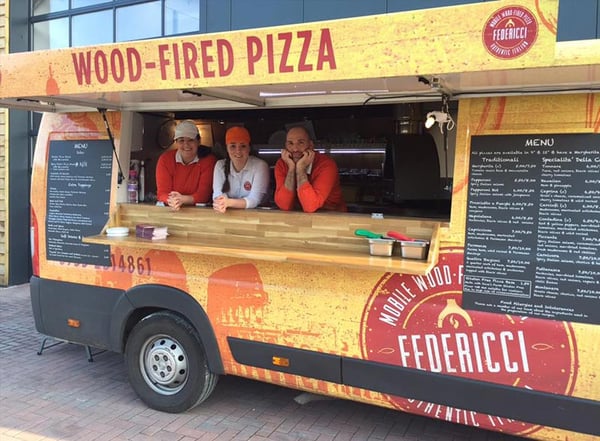Starting your own business is a big decision, so it's important to be aware of what can and does go wrong if you don't prepare accordingly.
In this article, we detail the top 7 reasons why food trucks fail, helping you avoid the common mistakes that set new business owners back.
The seven most common reasons why food trucks are unsuccessful are:
1. Lack of planning
If you’re starting any business, planning is key to keep you on track and visualise your goals. The following are common examples of where a business fails because start-ups have run before they can walk:
-
Failure to create a business plan
Creating a business plan is essential to bring clarity to your idea and see whether or not it is truly feasible. It will help you work out if you can afford to start your own business and when you can expect to start making a profit.
If you want some help, check out our business plan template. The template includes a spreadsheet we have created that lists all the items related to running a street food business that you will need to fund, so you can calculate the costs to include. -
Poor money management
Running out of funds before your profits start to materialise will pave the way for certain failure, which is why completing a forecast as part of your business plan is so important – it will help you to keep to your budget and steer clear of overspending. -
Choosing a food truck before deciding your menu
We often find that falling in love with a vehicle and buying it to convert into a food truck is a common way that a street food business starts. But it often leads to big problems. A cute little Piaggio Ape may look desirable, but won’t be able to accommodate all the cooking equipment you need if you want to sell fish and chips. The best way to start your vehicle search is to create a floor plan featuring all the equipment you will need to produce your menu. This will give you an accurate idea of the size vehicle you will need.
2. Being disorganised
Whatever system you prefer, be it spreadsheet, smartphone or Filofax, stay on top of things! Not getting your task and finance management in order can result in:
- Failure to reserve pitches in time – You can’t sell anything if you haven’t booked your place!
- Inept or unreliable staff – Take care to ensure staff you employ have genuine, good references, relevant experience and feel as passionate about your business as you do.
- Poor stock control – Having too much stock is a waste of money and food; not having enough will mean you lose valuable trading hours replenishing, so see if you can find out how much stock other, similar food trucks require to help you have more reliable stock control from the start.
- Failure to conduct reviews - Conducting regular reviews of what’s working and not working is a good way to keep you on the road to success. Check in after six months of trading – are you aligning with your business plan? Have you been carried away with the fun of running the business, without keeping tabs on the cash flow? Looking at things objectively will help you to put things right before it is too late and you’re forced to cease trading.
3. Wrong menu
While you man believe you have the tastiest menu out there, it’s got to tread a fine line between costs and that wow-factor. Here are the top menu mistakes to avoid:
-
Failure to research
Find out what’s trending with foodies on social media and which types of food trucks are doing a roaring trade - you can do this by attending events to see which food trucks have the longest queues. -
Using expensive ingredients
The cost of ingredients is an important factor to consider when deciding your menu. Will the ingredients be easy to source and cheap? It’s best to get a balance between your basic and luxury ingredients, but don’t be overly generous with the more expensive elements. A meal that is inexpensive to prepare can still look fantastic with a bit of imagination. The food takes too long to cook - Create menu options that are quick to prepare and cook on your food truck, or can be prepared at home in advance then cooked quickly on-site.
-
Storage problems
Are the ingredients for your menu bulky, requiring plenty of storage space, like potatoes? Unless you’re willing to make regular trips to a local supermarket for replenishments, you’ll need to have enough storage space for a day’s-worth of supplies. -
Poor food presentation
Make sure your serving area looks welcoming and tidy and the food is served in the right container to make it easy to eat. Being given a messy-looking meal that is difficult to eat without spilling it down your clothes is not a pleasant experience, so bear this in mind when choosing your menu and how it will be served.
Need inspiration?Here are a few of the most popular street food menu options that have low-cost ingredients as a base:
|
4. Wrong location

While your menu might be completely on-point, pitching at the wrong location is another common reason why food trucks fail, for the following reasons:
-
Failure to research
Does the area have the right customer profile for the food you will be serving? Will there be lots of competition from similar food trucks or is there a gap in the market? Will you have permission to park up a food truck in your desired location? Find out where there is the most footfall in the area you wish to target- a little bit of homework now will pay dividends later on. -
Attending the wrong type of events
Your food truck needs to fit in with the type of event you are attending so that you attract plenty of customers. If you’re not sure, visit various types of events first like weekly markets, craft events or music festivals to see what sort of food trucks are the most popular. -
Being in the right place, but at the wrong time
An area that has a buzzing night life may be quiet during the day and most seaside resorts will be extremely busy during the holiday season, but some are virtually deserted during the winter. Make sure you are aware of the ebb and flow of footfall when choosing a pitch.
5. Unrealistic Expectations
Starting your own business is an exciting time, but it’s important to be as objective as you can at the beginning. You may have this fantastic vision of how your business will look when it is up and running and has a great following, but have you really thought through the journey you will be going on to get there? Here are a couple of points to be mindful of:
-
Being overly ambitious
You will be setting yourself up for failure if you set targets that are impossible to meet. Make informed calculations of costs so your forecasted goals are realistic. -
Thinking it will be easier than it is to run a food truck
It will be tougher than you think, especially at the start. Remember you will be on your feet all day, for long hours, and it can be very stressful, especially if you are busy. You have to be willing to persevere until you can afford to hire another pair of hands.
6. Food truck not fit for purpose
An unsuitable vehicle is frequently the reason why food trucks fail, but if you have planned your business carefully, you will know exactly what features your food truck needs. Here are our top two pitfalls to look out for:
-
Travel and manoeuvrability
You will have sketched out a floor plan to make sure the vehicle is the right size and has the storage space you need, but you also need to think about where you will be taking your food truck. Will it have to travel long distances and will it be easy to manoeuvre onto a pitch at a food festival, for example? -
Unreliable vehicle
It is essential that your vehicle is reliable. Don’t be seduced by a visually appealing, vintage vehicle, without making sure it is mechanically sound before you buy it. The vehicle needs to be easy to maintain and source parts for, so your vehicle doesn’t become a cause of extra stress or worse, your business failing.
Here are a few examples of vehicles that make successful food trucks:
|
7. Poor marketing
Setting up a fabulous food truck serving delicious food will certainly attract interest from passers-by, but you can entice more customers with clever marketing. Lack of marketing strategy is another common reason why food trucks fail, and here’s why:
-
No clear brand identity
Your branding is essentially the name and appearance of your business. Your business name needs to make it clear what sort of food you are selling, like “Betty’s Vegan Cupcakes” or “Sizzling Sausages R Us” and you can build a personality into your brand identity, such as “fun”, “new-age” or “classy”. This branding can feature on your vehicle wrap, the interior décor of your food truck and even your aprons if your budget permits.
-
No advertising
If you advertise the launch of your new food truck beforehand, your potential customers will know when to expect you and what you will be selling. You can build up anticipation, to increase your chances of attracting customers when you first arrive. You can advertise by displaying posters in shop windows, delivering fliers and placing an advert in the local newspaper. You can also advertise widely, and cheaply, on social media. -
No online presence
If you don’t embrace the internet and exploit it to its best advantage, your business is highly likely to be eclipsed by competitors who do. Ideally, you should be doing the following things to help your business stand out from the crowd:- Build a website, if you have the budget/know-how. A website is a good place for your followers to see your itinerary, if you are travelling to different locations. It can also be a good platform to showcase your menu and prices.
- Have a presence on social media, e.g. Facebook, Instagram, Twitter etc. Social media is largely where food trends are discovered, and you can create a real buzz around your truck, with lots of announcements and photos. It costs nothing and taking the time to build a social media presence will pay dividends in cultivating a loyal following.
- Set up an online ordering system via your website or a QR code on your menu. This is a possible avenue to explore if you have a regular pitch/pitches because it will enable people to order ahead and avoid queues.
What are my next steps?
There are other, more personal reasons why food trucks fail but this blog lists the main reasons to be aware of when planning to start a street food business.
If you want to start your food truck business the right way, check out our Ultimate Guide to Street Food Trucks.
You will learn how to develop your ideas into a business plan, how to fund your business, how to plan a menu, how to attract customers, regulations and permits, how to find and purchase a quality vehicle and how to convert it into the mobile kitchen of your dreams!

